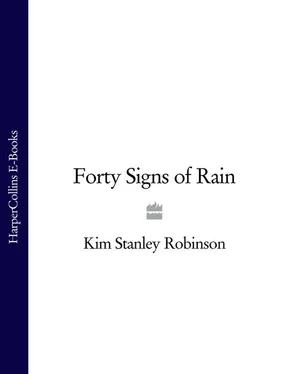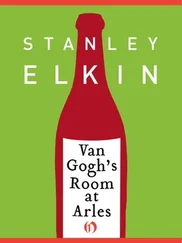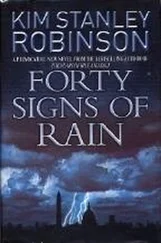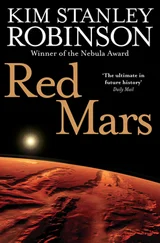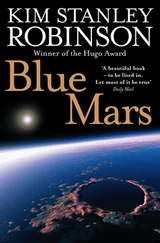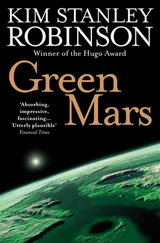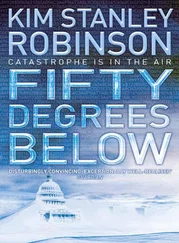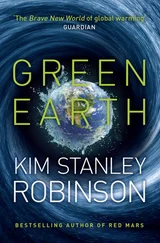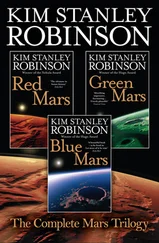Anna appeared in the doorway, tapping on the doorjamb as she always did, to pretend that his space was an office. ‘Frank, I forwarded that jacket to you, the one about an algorithm.’
‘Let’s see if it arrived.’ He hit CHECK MAIL, and up came a new one from aquibler@nsf.gov . He loved that address. ‘It’s here, I’ll take a look at it.’
‘Thanks.’ She turned, then stopped. ‘Hey listen, when are you due to go back to UCSD?’
‘End of July or end of August.’
‘Well, I’ll be sorry to see you go. I know it’s nice out there, but we’d love it if you’d consider putting in a second year, or even think about staying permanently, if you like it. Of course you must have a lot of irons in the fire.’
‘Yes,’ Frank said noncomittally. Staying longer than his one-year stint was completely out of the question. ‘That’s nice of you to ask. I’ve enjoyed it, but I should probably get back home. I’ll think about it, though.’
‘Thanks. It would be good to have you here.’
Much of the work at NSF was done by visiting scientists, who came on leave from their home institutions to run NSF programmes in their area of expertise for periods of a year or two. The grant proposals came pouring in by the thousand, and programme directors like Frank read them, sorted them, convened panels of outside experts, and ran the meetings in which these experts rated batches of proposals in particular fields. This was a major manifestation of the peer review process, a process Frank thoroughly approved of – in principle. But a year of it was enough.
Anna had been watching him, and now she said, ‘I suppose it is a bit of a rat race.’
‘Well, no more than anywhere else. In fact if I were home it’d probably be worse.’
They laughed.
‘And you have your journal work too.’
‘That’s right.’ Frank waved at the piles of typescripts: three stacks for Review of Bioinformatics , two for The Journal of Sociobiology . ‘Always behind. Luckily the other editors are better at keeping up.’
Anna nodded. Editing a journal was a privilege and an honour, even though usually unpaid – indeed, one often had to continue to subscribe to a journal just to get copies of what one had edited. It was another of science’s many non-compensated activities, part of its extensive economy of social credit.
‘Okay,’ Anna said. ‘I just wanted to see if we could tempt you. That’s how we do it, you know. When visitors come through who are particularly good, we try to hold on to them.’
‘Yes, of course.’ Frank nodded uncomfortably, touched despite himself; he valued her opinion. He rolled his chair towards his screen as if to get to work, and she turned and left.
He clicked to the jacket Anna had forwarded. Immediately he recognized one of the investigators’ names.
‘Hey Anna?’ he called out.
‘Yes?’ She reappeared in the doorway.
‘I know one of the guys on this jacket. The PI is a guy from Caltech, but the real work is by one of his students.’
‘Yes?’ This was a typical situation, a younger scientist using the prestige of his or her advisor to advance a project.
‘Well, I know the student. I was the outside member on his dissertation committee, a few years ago.’
‘That wouldn’t be enough to be a conflict.’
Frank nodded as he read on. ‘But he’s also been working on a temporary contract at Torrey Pines Generique, which is a company in San Diego that I helped start.’
‘Ah. Do you still have any financial stake in it?’
‘No. Well, my stocks are in a blind trust for the year I’m here, so I can’t be positive, but I don’t think so.’
‘But you’re not on the board, or a consultant?’
‘No no. And it looks like his contract there was due to be over about now anyway.’
‘That’s fine, then. Go for it.’
No part of the scientific community could afford to be too picky about conflicts of interest. If they were, they’d never find anyone free to peer-review anything; hyper-specialization made every field so small that within them, everyone seemed to know everyone. Because of that, so long as there were no current financial or institutional ties with a person, it was considered okay to proceed to evaluate their work in the various peer-review systems.
But Frank had wanted to make sure. Yann Pierzinski had been a very sharp young bio-mathematician – he was one of those doctoral students whom one watched with the near certainty that one would hear from them again later in their career. Now here he was, with something Frank was particularly interested in. Frank’s curiosity was piqued.
‘Okay,’ he said now to Anna. ‘I’ll put in the hopper.’ He closed the file and turned as if to check out something else.
After Anna was gone, he pulled the jacket back up. ‘Mathematical and Algorithmic Analysis of Palindromic Codons as Predictors of a Gene’s Protein Expression.’ A proposal to fund continuing work on an algorithm for predicting which proteins any given gene would express.
Very interesting. This was an assault on one of the fundamental mysteries, an unknown step in biology that presented a considerable blockage to any robust biotechnology. The three billion base pairs of the human genome encoded along their way some hundred thousand genes; and most of these genes contained instructions for the assembly of one or more proteins, the basic building-blocks of organic chemistry and life itself. But which genes expressed which proteins, and how exactly they did it, and why certain genes would create more than one protein, or different proteins in different circumstances – all these matters were very poorly understood, or completely mysterious. This ignorance made much of biotechnology an endless and very expensive matter of trial-and-error. A key to any part of the mystery could be very valuable.
Frank scrolled down the pages of the application with practised speed. Yann Pierzinski, PhD bio-maths, Caltech. Still doing post-doc work with his thesis advisor there, a man Frank had come to consider a bit of a credit hog, if not worse. It was interesting, then, that Pierzinski had gone down to Torrey Pines to work on a temporary contract, for a bioinformatics researcher whom Frank didn’t know. Perhaps that had been a bid to escape the advisor. But now he was back.
Frank dug into the substantive part of the proposal. The algorithm set was one Pierzinski had been working on even back in his dissertation. Chemical mechanics of protein creation as a sort of natural algorithm, in effect. Frank considered the idea, operation by operation. This was his real expertise; this was what had interested him from childhood, when the puzzles solved had been simple ciphers. He had always loved this work, and now perhaps more than ever, offering as it did a complete escape from consciousness of himself. Why he might want to make that escape remained moot; howsoever it might be, when he came back he felt refreshed, as if finally he had been in a good place.
He also liked to see patterns emerge from the apparent randomness of the world. This was why he had recently taken such an interest in sociobiology; he had hoped there might be algorithms to be found there which would crack the code of human behaviour. So far that quest had not been very satisfactory, mostly because so little in human behaviour was susceptible to a controlled experiment, so no theory could even be tested. That was a shame. He badly wanted some clarification in that realm.
At the level of the four chemicals of the genome, however – in the long dance of cytosine, adenine, guanine and thymine – much more seemed to be amenable to mathematical explanation and experiment, with results that could be conveyed to other scientists, and put to use. One could test Pierzinski’s ideas, in other words, and find out if they worked.
Читать дальше
